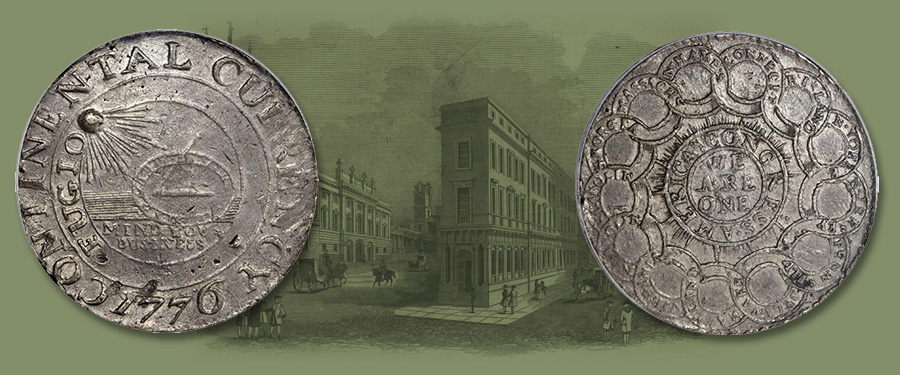
No specific documentation has ever been found detailing the
origins of the enigmatic Continental "dollar.” The vast majority of
surviving examples were struck in pewter, although a few silver and brass
impressions are also known. These interesting early American pieces are very
popular and always attract attention when we offer one at auction.
in lot
247 of our June 2020 Santa Ana auction we present a desirable bold pewter
example graded EF-45 (PCGS). It displays dove-grey patina and has hints of
original luster in the protected areas. A few moderate marks are noted across
the obverse, but these are ancient and nicely worn into the complexion. The
reverse is admirably preserved and has no remarkable distractions.
The earliest known published record of the Continental
dollar came, oddly enough, in the German book Historical and Genealogical
Almanac, or Yearbook of the Most Remarkable New World Events for 1784 by
Matthias Christian Sprengel. A few years later, in 1786, Bishop Richard
Watson’s Chemical Essays (Volume IV) also mentioned the Continental
"dollar."
As tempting as it is to assign primary source status to the
Sprengel and Bishop Watson accounts because they date to the 1780s, recent
research and a two-part article by Erik Goldstein and David McCarthy entitled
"The Myth of the Continental Dollar" published in the January and
July 2018 editions of The Numismatist challenge the long accepted
theories surrounding these coins. They discovered that a long string of early
Americans — people who were actually in a position to provide concrete facts
about these pieces — went on the record to mention that they had never seen or
heard of such a thing as a Continental dollar coin. Paul Revere and Josiah
Meigs both went on the record within a decade of the end of the American
Revolution to correct Bishop Watson’s report that the pewter "dollar"
was an American coin.
That the Continental "dollar" was intended as a
medal and not a coin, and that it was struck in London in 1783 instead of an
unknown American location in 1776, changes very little in the scheme of things.
It remains scarce, attractive, historic and valuable. It’s a piece that Paul
Revere — no man of letters, typically — felt passionately enough about to write
a missive to the Bishop of London.
This sharp EF-45 (PCGS) in pewter will be offered in lot
247 of our June 2020 Santa Ana Auction,
featured alongside Vermont coppers from the Q. David Bowers Collection,
the Dazzling Rarities Collection, the Francesca Collection of US Gold Coins,
and many other rarities. The sale is currently available for bidding and viewing
on our website www.StacksBowers.com or
you may contact us to secure a copy of the printed catalog. Also, download our
mobile app to view and participate in our auctions via your Android or Apple
device.





